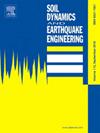Strain-dependent dynamic properties of compacted clay-sand mixtures
IF 4.2
2区 工程技术
Q1 ENGINEERING, GEOLOGICAL
引用次数: 0
Abstract
Compacted clay-sand composites, as a type of gap-graded soils, are widely used in a variety of geotechnical engineering projects such as the core of embankment dams, the foundation of offshore structures, and impermeable blankets in waste disposal landfills. In this study, a comprehensive series of resonant column and torsional shear tests is carried out to investigate the strain-dependent dynamic shear modulus and damping ratio of clay-sand mixtures. The significant effects of isotropic confining pressure, relative compaction, aggregate content, and plasticity index of the fines portion on the shear modulus degradation curve, strain-dependent normalized shear modulus, and damping characteristics of compacted clay-sand mixtures are systematically examined. The results show that the shear modulus of the composites increases with increasing isotropic confining pressure and decreasing plasticity index. It is also observed that the effect of sand content on the strain-dependent shear modulus increases with increasing confining pressure. In addition, the normalized shear modulus decreases and the damping ratio increases with the increase in the sand content of the compacted mixtures. Relative compaction is also observed to have an insignificant effect on the strain-dependent shear modulus and damping characteristics of composites. Based on the experimental results and considering the influences of all controlling parameters, several empirical equations are developed to evaluate the strain-dependent shear modulus and damping ratio of compacted clay-sand composites. The proposed equations could be readily utilized in practice for the seismic stability analysis of various geo-structures comprising compacted gap-graded composites.
压实粘土-砂混合料的应变相关动力特性
压实粘土-砂复合材料作为一种间隙级配土,广泛应用于各种岩土工程中,如堤防坝芯、近海结构物基础、垃圾处理填埋场防渗毯等。在本研究中,进行了一系列全面的共振柱和扭剪试验,以研究粘土-砂混合物的应变相关动剪切模量和阻尼比。系统研究了各向同性围压、相对压实度、骨料含量和细粒部分塑性指数对粘土-砂混合体的剪切模量退化曲线、应变相关归一化剪切模量和阻尼特性的显著影响。结果表明:复合材料的剪切模量随各向同性围压的增大而增大,塑性系数随各向同性围压的减小而减小;含砂量对剪切模量的影响随围压的增大而增大。随着掺砂量的增加,归一化剪切模量减小,阻尼比增大。相对压实对复合材料应变相关剪切模量和阻尼特性的影响也不显著。在试验结果的基础上,考虑各控制参数的影响,建立了粘土-砂复合材料应变相关剪切模量和阻尼比的经验方程。所提出的方程可以很容易地用于实际中各种由密实间隙梯度复合材料组成的土工结构的地震稳定性分析。
本文章由计算机程序翻译,如有差异,请以英文原文为准。
求助全文
约1分钟内获得全文
求助全文
来源期刊

Soil Dynamics and Earthquake Engineering
工程技术-地球科学综合
CiteScore
7.50
自引率
15.00%
发文量
446
审稿时长
8 months
期刊介绍:
The journal aims to encourage and enhance the role of mechanics and other disciplines as they relate to earthquake engineering by providing opportunities for the publication of the work of applied mathematicians, engineers and other applied scientists involved in solving problems closely related to the field of earthquake engineering and geotechnical earthquake engineering.
Emphasis is placed on new concepts and techniques, but case histories will also be published if they enhance the presentation and understanding of new technical concepts.
 求助内容:
求助内容: 应助结果提醒方式:
应助结果提醒方式:


